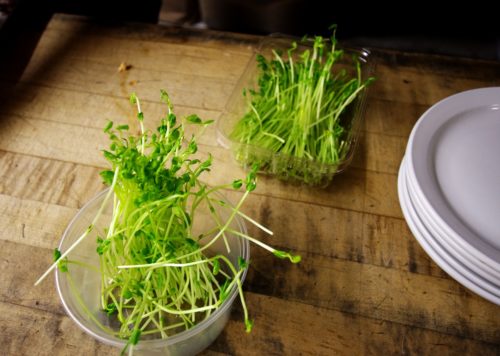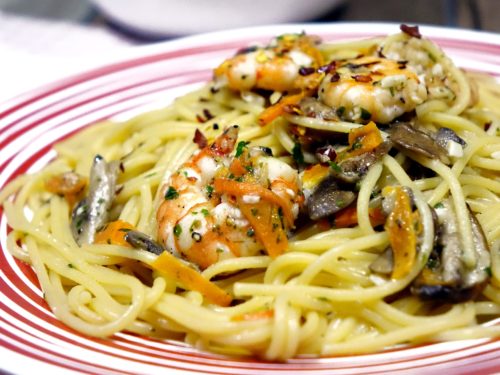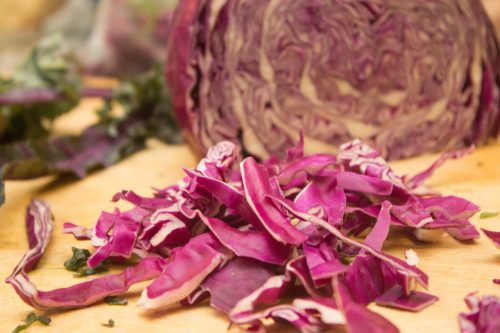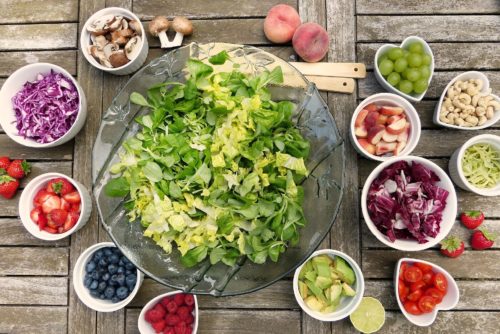We've been inundated with home meal services in the last couple of years. If you're a podcast fan, you probably hear about a new one every other week from hosts who rave about the delicious, meals they've served their family. However, since the idea for a meal service began, aspiring home chefs have run into a problem: there are too many meal services to choose from!
In this article, we'll break down the differences between Home Chef vs Blue Apron vs Plated. Each one comes with its own particular meals, customizable features, and, of course, prices. Read on to find out which of these services you need to try and which ones you can skip.
What's A Meal Service?
A meal service lets you become a cordon bleu chef for a night with pre-measured, pre-chopped ingredients. These arrive in an insulated box in the mail, normally once a week, with all the prep complete. Each service allows you to customize ingredients and recipes so that you don't have to endure a food you know you'll hate or contend with an ingredient to which you're allergic.

Along with the individually bagged ingredients, each box includes a list of detailed instructions showing you exactly how to make the meal. You may need to provide some basic spices, like salt and pepper, or a dash of olive oil, but otherwise, your only contribution is the effort involved. Frankly, most of the effort of cooking seems to be the chopping process anyway. Using a meal kit can cut down your cooking time by half or more. It can take a lot of the guesswork out of meal planning, too. If you just don't have room in your day for grocery shopping, prep time, and fixing healthy meals, it's easy to see how a meal service might be worth your money.
Meal Kits Are Subscriptions
Meal kits tend to be subscription models. In other words, you'll sign up for a year and receive boxes on a regular schedule. There are multiple plans available from most meal services, ranging from just a couple recipes per week to enough food to feed multiple people for several days. In general, the larger packages are a better deal, but meal services are still pricey compared to making meals from scratch. Individual servings generally cost between $7.99 and $9.99, as compared to under $5 for meals from scratch. In some cases, the actual cost is a little higher due to shipping.
Why Use A Meal Service?
So why do people use meal services? For one thing, they're generally the cheaper option when compared to eating out. Even if you don't rely heavily on restaurants, chances are good that you're still paying too much to have your food made for you. Most Americans spend about $232 eating out every month – that's over $2,700 per year! According to The Simple Dollar, every meal you eat out averages $12.75 in cost. An estimate in Forbes places the price tag of a dinner out even higher, although it doesn't average in low-cost meals like pizza and fast food. In comparison, Plated's most basic package, which costs $35.85 a week, would only put you back $1,864.20 in 2019. If you can replace restaurant meals with a meal service, you should.

That said, going the meal service route will require you to stick to your guns. If you can't break your restaurant food habit, then you could end up both eating out and paying for a meal service. This would make your food costs soar, so be sure that you can give up diner breakfasts and pizza dinners before you commit to a subscription. Be aware also that portion sizes are optimized for meal kits, but inflated at restaurants. You might be able to make a $25 restaurant splurge stretch two days, but a $9.95 serving from Blue Apron will last exactly one meal. It might help to know what's out there. Not all meal services are created equal, and your success with this strategy very much depends on choosing the right subscription for you.
Home Chef

There are a ton of meal service options out there. We'll examine three of the most popular services in this article, starting with Home Chef. Why start with this service? Because this is the one you're most likely to run into if you've shopped at Kroger's and Walmart.
History
In 2013, Pat Vihtelic, an ex-investment analyst and recent student of web design, started Home Chef. Four years later, the company was running a booming business, not just mailing out meals, but selling through Walmart's website too. More recently, Home Chef was acquired by the popular grocery chain Kroger. We're familiar with this popular grocery chain here at The Budget Diet because they own and operate Food 4 Less, which we've spotlighted as one of the 7 cheapest warehouse clubs out there. Seniors also get a healthy discount on Kroger food if they use their Kroger card.
Individual pre-prep meals are now available at a handful of Kroger stores, with more expected to add single-meal kits in 2019. The boxes start at $8.50 per serving. Meanwhile, the subscription program is still thriving. In March of 2018, immediately prior to its acquisition, Home Chef claimed to be delivering three million meals every month to subscribers alone.
Products
Home Chef's menu rotates. At any given time, subscribers get to choose between fifteen options; these tend to be most appropriate for dinner. Each menu also offers a premium meal, such as lamb chops, that costs significantly more than the standard options. In the case of the lamb chops, each serving would cost $19.95.

Each menu option lists allergens and cooking time. While there are no vegetarian options shown in this row, there are several available, from crispy ginger tofu rice to spicy plantain and black bean tacos. The tofu rice also appears to be the only vegan option on this particular menu. Each menu includes three vegetarian meal options out of the fifteen available recipes, but there's no guarantee that any of them will be vegan. Every menu also includes two optional add-ons at $4.95 per serving. These are usually smoothies and a basket of seasonal fruit.
Pick Your Meals Ahead Of Time
It's possible to choose your meals up to five weeks ahead with Home Chef. During that time, menu items don't repeat. However, customer favorites pop up fairly regularly, so if you do use this service, keep track of what you like. If you really can't wait, then the company boldly gives away every recipe on its website. Even if you're not a subscriber, you can click on a menu entry and receive detailed instructions on how to make that meal, exactly like you'll get on the recipe cards that Home Chef sends with every box.
This isn't a huge surprise – none of what Home Chef presents is impossible to make on your own for less money. The deal is in the time and effort saved by ordering a subscription instead of shopping and chopping. If you're OK with prepping your own ingredients, then you could make Home Chef meals every night. However, if you're OK with prepping your own ingredients, then delivery services probably aren't for you anyway!
Finally, Home Chef does offer gift certificates. One way to test how your family might like this service is to use it as a holiday present for a family member or friend, and then see how they react.
Dietary Restrictions
While there aren't explicit kosher, halal, or beef-free options, the service's onboarding survey does allow users to opt out of several ingredients, including pork, red meat, and shellfish. This opt-out comes with a caveat: if you try to generate a vegan meal by opting out of all animal products on the onboarding survey, then Home Chef's website won't let you continue to check out on the basis that it can't meet your dietary needs. Unfortunately, we have to conclude that Home Chef just isn't vegan-friendly. In a food landscape where more and more eaters are choosing plant-based approaches to dinner, we suspect that this will someday change. For now, however, vegans who want to order Home Chef should have some almond milk on hand for substitutions.
Image from Home Chef
Pricing
Home Chef's big disadvantage is that it's hard to find pricing information on its homepage. If you dig into the FAQs, you can find a chart that very briefly summarizes its costs. At $7.99, one serving of lunch is competitive with a decent-sized fast food meal. “Standard” meals – that is, dinner items – come to about $9.95. The size of your weekly bill will depend on how many of each you'd get in your box, so it's still a little hard to know what the total monthly bill would be without opening an account and proceeding through the onboarding survey to the checkout screen. And who wants to do that? That's why you have The Budget Diet!

The plan shown above is close to the default option for Home Chef. Pricing depends on how many meals you want to cook every week, and for how many people. The maximum size of a meal plan is 6 meals for six people at $358.20 per week. This is undeniably the largest box we've seen, making Home Chef the best meal service for a family plan. The minimum size, two meals per week for two people, costs $49.80 with shipping. (Orders over $45 ship for free.) This state of affairs suggests the possibility of stretching a two-for-two box into four meals if you happen to be single and live alone. However, adding in shipping, your meals would still cost $12.45 per serving. You'd actually save money if you went out for pizza four times a week.
Beware Of Add-ins!
However, that price also doesn't count the tempting extras, like the fruit baskets and the premium meals, which can make this price skyrocket. It's worth noting that the menus don't list whether individual items are standard or lunchtime affairs, so their actual per-serving costs aren't clear at all.
| Pros | Cons |
|
|
Plated
If you like TV, you might know about Plated already. This meal service is a bit of a star in its arena thanks to a breakout on ABC's Shark Tank in 2014. Otherwise, however, there are a number of notable parallels with Home Chef, including a grocery store acquisition.
History
Nick Taranto and Josh Hix, two Harvard Business School grads, founded Plated in 2012. Initially, their food was lousy and their customers unreliable, but Taranto had worked for Goldman Sachs and the duo were not newcomers to fundraising. In 2013, they also brought chef Elana Karp on board to improve the food. For the next several years, they saw their fledgling company through funding, deals, and, of course, a popular ABC business reality TV show. It all paid off in 2017, when the grocery giant Albertsons, owner of ACME and Safeway, bought Plated for $200 million. Like Home Chef, this company rolled out pre-prepped meals in its stores in 2018. If you live near a Shaw's or a Star Market, you can now find Plated meals in the aisles. Click here to find a store that stocks Plated in your zip code!

Products
Like Home Chef, Plated offers several different possible combinations of meals based on the number of people you're cooking for and how many nights a week you intend to cook. Unlike Home Chef, this information is readily available on Plated's homepage. This is useful for more than one reason: by looking at the pricing page, it's easy to notice that Plated doesn't provide food for more than four people per meal. In contrast to Home Chef, which offers plans that cover six people for six nights, this is fairly meager. If you've got a large family, it may even be a dealbreaker.
However, Plated does offer greater variety than Home Chef. Each week, users can choose from a menu of 20 different meals. Even at a glance, there's a difference in flavour adventurousness between the Home Chef meals and Plated. Where Home Chef offers chicken, Plated might offer duck. Other meal items include calamari and salmon. If you're the kind of eater eager to try a fresh purple carrot just for the experience, Plated may be your ideal delivery service. Plated also offers dessert, something that Home Chef has yet to do. Plated lets you see the ingredients it'll send on each meal's information page, but that's as far as they'll go. The full recipe is only available in the box.

Unusual Recipes For Adventurous Eaters
Clearly, Plated specializes in food that you wouldn't normally cook at home. The fact that they don't make their recipes available suggests that they know they're using some unusual, possibly intimidating ingredients. Unlike Home Chef, which features familiar staples, Plated is offering an adventurous cooking and eating experience that might not even be available at your local restaurants. Plus, who wouldn't like to brag that they cooked duck for dinner last night?
Plated offers the option to choose what day of the week you get your deliveries. According to their website, food stays cold in their insulated boxes until midnight of the day of delivery. You can also skip weeks if necessary.
Dietary Restrictions
Unlike Home Chef, Plated does not give you options to add dietary restrictions before you enter your credit card information. Instead, you'll need to check out their menus first. A slider located at the top of the menu will give you options for vegetarian, low-calorie, and “family-friendly” recipes, as well as seafood, meat, and dessert. We can only assume that there are ways to eliminate common allergens, like peanuts, from menus, but whether it's possible to eliminate pork or beef is a question that we couldn't answer.
If you eat kosher, halal, or plant-based, you may not have options available. On the Plated menu that we inspected, there were no available meals suitable for vegans. There are four vegetarian options on each menu, not counting dessert.

Plated claims that its food is “thoughtfully sourced,” but the exact meaning of this statement is not completely clear. According to an article on Morsel, Plated's blog, thoughtful sourcing includes using some organic ingredients, but details remain sketchy. How much of Plated's food is organic? Is the food local? Ethically raised? Grown on small family farms? The words “thoughtfully sourced” appear again and again, but never seem to get a definition. Providing fresh ingredients out to be a baseline requirement for meal kits, so color us unimpressed by this nebulous claim.
Pricing
Plated's prices come in a little lower than Home Chef's. Where Home Chef sells three meals for two people at $59.70 per week, Plated offers the same package at $43.80, but there's an $11.95 discount applied. We assume that this might run out at some point, leaving you with a weekly bill of $55.75. However, the most expensive plan, which feeds four people for four meals, comes in at $159.20 before the discount. Serving costs fall as low as $9.95 for large plans, and shipping is free for orders over $60.
| Pros | Cons |
|
|
Blue Apron
Even people unfamiliar with meal services might know about Blue Apron. It's one of the oldest and best-established fixtures on the meal kit landscape. It's also famously a podcast advertiser, and excited-sounding podcasters have been gloating over their “home-cooked” meals in between segments for years. But what's behind the hype?

History
Blue Apron may be the only meal delivery services to be traded on the New York Stock Exchange. It went public in 2017, about five years after launching. Blue Apron is also the brainchild of a Harvard Business School alum: Mark Salsberg went there before working as a venture capitalist and eventually starting Blue Apron. His co-founders Ilia Papas and Matthew Wadiak are a software engineer and a chef respectively.
Blue Apron may have gotten the most attention of any meal service, but being highly visible isn't always a good thing. Due to increased competition from Plated, Home Chef, and other meal kit services, its stock has fallen and it's had to restructure. Nonetheless, it's a strong company with good food and potentially a strong future. Read on to find out why it's considered the trailblazer in this industry.
Products
When it comes to products, Blue Apron is definitely the best-developed of all the meal prep service companies we've examined in this article. This is probably the result of its age and independent status. Expect this company to continue outdoing itself to try and stand out from the pack.
Meanwhile, if you're lost over a no-clutter gift for a friend or relative, you might consider a Blue Apron gift card. Those are available on its website in increments of $60, $120, and $240, as well as a customizable field. $120 covers two weeks of Blue Apron food for two people.

Blue Apron Wine
Blue Apron doesn't just offer food – it delivers wine, too! Using vintages specially fermented for this company, each delivery gives you a bottle of something that is as yet unavailable in stores. The two-serving-sized bottles also come with notes about tasting and pairing. If you don't want to wait on pairing, Blue Apron will pair the wine with your Blue Apron meals as part of your subscription.
The Market on Blue Apron's homepage is also impressively stocked, not just with kitchen utensils and gear, but sometimes with selections of cheeses or spice mixtures. Most of the swag in this section is fairly standard stuff, ranging from aprons to knives. We'll discuss the prices in this online store a little further along in this article.
Recipes For Free
Like Home Chef, Blue Apron offers some recipes on its site. Check out this beef stir-fry or this meal of chicken and green beans for good examples. It helps Blue Apron's credibility that it lets the public have its recipes for nothing. After all, the service they offer is convenience, not the basic ability to cook.
Each weekly Blue Apron menu includes eight meal choices. Interestingly, that's the smallest selection of any of the services we've seen so far. Only dinners appear on the online menus, although that doesn't eliminate the possibility of leftovers for lunch. Although Blue Apron remains its own entity, a few of its meals are available at some Costco stores.

Dietary Restrictions
Blue Apron does provide an explicit vegetarian menu. This appears to be three vegetarian dishes from the standard menu of eight. On the plus side, this means that almost 40% of Blue Apron's menus are vegetarian! However, vegans must once again be disappointed. Vegetarian Blue Apron recipes rely heavily on cheese and eggs. Unlike Home Chef and Plated, Blue Apron offers no option for gluten-free meals.
Otherwise, Blue Apron lets you eliminate ingredients after checkout, so we were unable to see if it lets you eliminate pork or beef, or if it has a kosher option. As with Plated, we assume that it lets you remove allergens from meals. One of Blue Apron's plans also delivers food tailored to people who are on the program.

On its blog, Blue Apron discusses their commitment to ethical treatment of animals that provide food for the service. They also provide some satisfying numbers: 100% of eggs are from pasture-raised hens, 40% of beef comes from pasture-raised cattle, and none of the animals whose products they use are fed antibiotics. While we're relying on the company's word, it's encouraging that they are confident enough to post these figures.
Pricing
The smallest Blue Apron subscription available provides food for two people twice per week. This costs $47.95, which is the cost of four servings at $9.99 plus $7.99 shipping. Shipping is free on any order larger than that. Blue Apron's largest option feeds four people four times per week, costing a total of $119.84. Of the three services this article has covered, this is definitely the best deal.

The Blue Apron Market is not a useful buying option. Most of the items available there are basic kitchen gadgets, and the ones that aren't, like ramekins, are often available elsewhere for an equal or lower price. Savvy shoppers know that these turn up in thrift stores quite regularly, and even buying a set new from a big-box retailer might cut down on costs just because it would eliminate the need for shipping. As go ramekins, so go aprons, measuring spoons, and pizza paddles. Even rarer items like marinade injectors are available from places like Target. The verdict: resist the urge to shop in Blue Apron's visually appealing online showroom.
| Pros | Cons |
|
|
The Final Word
Each of the meal kit services we explored had its positives and negatives, but let's be honest: you want to know which one is the best deal for the cost. Between deals, shipping costs, and other details, the pricing costs listed on the websites for these services were not always consistent with what we'd find when we signed up. To determine who had the best plan for the money, we signed up for the exact same plan from each service and put the information we'd found on a table. The results were interesting.
| 2 meals for 2 people | 4 meals for 4 people | |
| Home Chef | $49.80 | $159.20 |
| Plated | $55.75 | $159.20 |
| Blue Apron | $47.95 | $119.84 |
Although Plated seemed to be the most expensive service at first glance, it quickly became clear that its large order prices were on par with Home Chef. Of course, that depends on you resisting Home Chef's pricey premium meals, which cost almost as much as a night out at a fancy restaurant. Blue Apron was the price champion from start to finish, although large orders definitely save more money. Plated also offered the widest variety of menu options, including our favorite course: dessert.

Getting Meal Kits In Stores
All three of the meal services sell through grocers, although of the three, two are actually owned by large food retailers. Unless Blue Apron itself is acquired by a grocery chain, Home Chef and Plated are likely to see higher distribution in the future. This is important for you because you may want a chance to try these meals before you buy a subscription. What if you don't happen to like duck meatballs, apple-braised pork loin, or lemon meringue? It's better to know before you spend $55.75 on your first week. If you happen to live close to a store that sells meal service boxes, then treat yourself and bring one home to test. If not, keep an eye out for them. In the case of Home Chef, you can even put together your own meal kit based on their website's online recipes.
Limited Vegan Options
While each service offered vegetarian options, none were particularly convenient for vegans. If you want to use a meal service and eat plant-based, then it's advisable to prepare. You can substitute your own vegan-friendly ingredients for dairy products and eggs, or even simply leave dairy ingredients out. That said, you'll be paying for food that you don't eat – not a very budget-friendly strategy. You might be better off trying Green Chef, a meal kit that caters to vegan, vegetarian, pescatarian, keto, and paleo eaters. Go check out their page now – you won't regret it! Religious dietary restrictions shouldn't be much of a problem unless you need your meals certified kosher or halal. Otherwise, it's entirely possible to cherry-pick meals that don't violate your eating rules.

Waste and Trash
Meal kits might save you money if you can use them to cut out your restaurant spending. That said, they generate a ton of discarded, nonrecyclable packaging, even though they may cut down on food waste. This is a serious consideration if you have to pay for your trash disposal.
So which meal service is right for you? It depends! Home Chef is better for big families, Plated caters to people who like new experiences, and Blue Apron is affordable and able to send wine. If you're not sure, we recommend asking a relative for a Blue Apron or Home Chef gift card for your next holiday or birthday gift. That way, you can try the format and see how it works for you.
